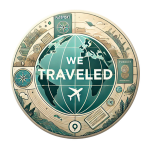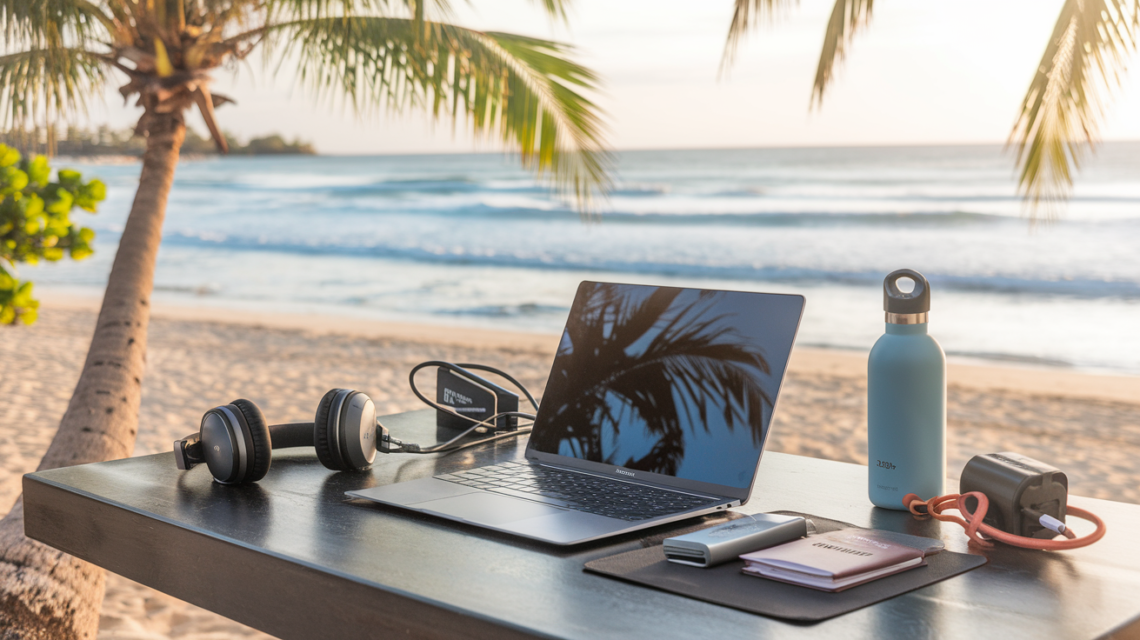In an era where the traditional 9-to-5 office setup is rapidly evolving, the digital nomad lifestyle has exploded in popularity, with over 35 million digital nomads worldwide as of 2023. More professionals than ever are discovering the freedom of combining their careers with their wanderlust, making remote work travel tips more valuable than ever before.
Imagine starting your workday in a beachside café in Bali, taking your lunch break to explore ancient temples, or conducting team meetings with the backdrop of the Swiss Alps. This isn’t just a dream – it’s the reality for many location-independent professionals who have mastered the art of working remotely while traveling.
In this comprehensive guide, you’ll discover essential strategies for maintaining productivity while exploring the world, from setting up your mobile office to managing time zones effectively. Whether you’re a seasoned digital nomad or just starting to consider the remote work travel lifestyle, we’ll cover everything you need to know about:
-
Creating a sustainable work-travel balance
-
Essential tech setup and connectivity solutions
-
Choosing the perfect work environments worldwide
-
Maintaining professional relationships across time zones
-
Protecting your health and work-life harmony on the road
Let’s dive into the ultimate collection of remote work travel tips that will transform your working holiday from challenging to seamless.
Planning Your Remote Work Travel Journey

Success in remote work travel starts with meticulous planning. Let’s break down the essential elements you need to consider before embarking on your digital nomad adventure.
Essential Pre-Travel Preparations
Work Visa Requirements
Before packing your laptop and dreaming of exotic destinations, research your legal right to work in your chosen countries. Many nations now offer specific digital nomad visas, including popular destinations like Portugal, Croatia, and Estonia. These typically require proof of stable income and health insurance.
Insurance Considerations
-
Travel insurance with laptop coverage
-
International health insurance
-
Income protection insurance
-
Liability coverage for remote work
Destination Research
Thoroughly investigate potential locations based on:
-
Internet infrastructure (minimum 20Mbps recommended)
-
Cost of living vs. your income
-
Local coworking space availability
-
Safety ratings and healthcare quality
-
Climate and seasonal considerations
Time Zone Planning
Map out your work schedule considering:
-
Team collaboration hours
-
Client meeting windows
-
Core business hours in your home country
-
Buffer zones for deadline management
Creating a Sustainable Travel Schedule
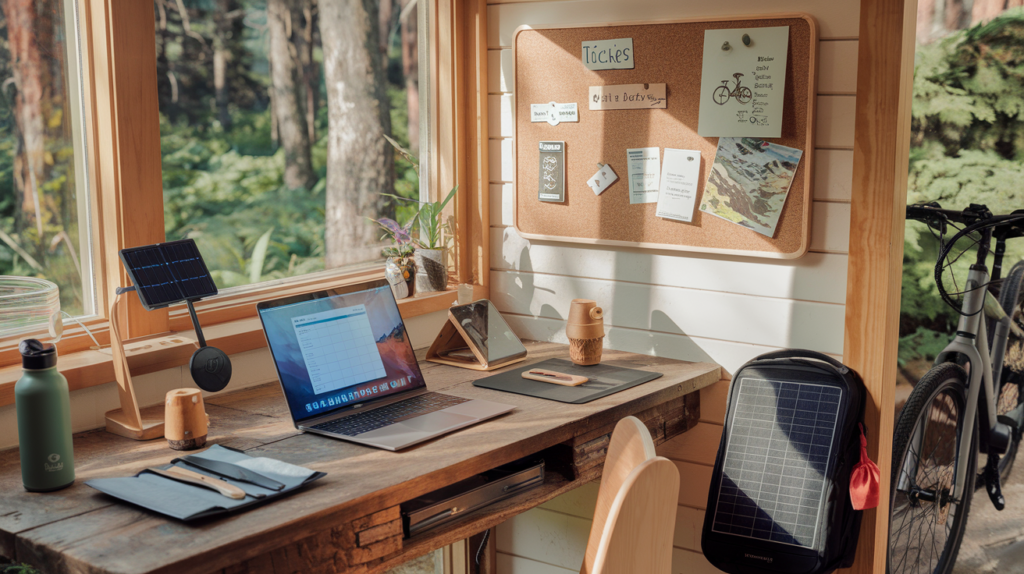
Balancing Work and Exploration
The key to successful remote work travel lies in creating a realistic schedule that honors both your professional commitments and travel aspirations. Consider:
-
Dedicating specific days for exploration
-
Working during off-peak tourist hours
-
Building in buffer days between locations
-
Planning longer stays (minimum 1 month) in each destination
Setting Realistic Expectations
Remember:
-
You won’t be able to see everything
-
Some work days will be just like at home
-
Factor in jet lag recovery time
-
Include rest days to prevent burnout
-
Allow flexibility for unexpected opportunities
Pro Tip: Start with “slower travel” – spending 1-3 months in each location. This approach allows you to maintain work productivity while truly experiencing each destination.
Essential Tech Setup for the Traveling Remote Worker
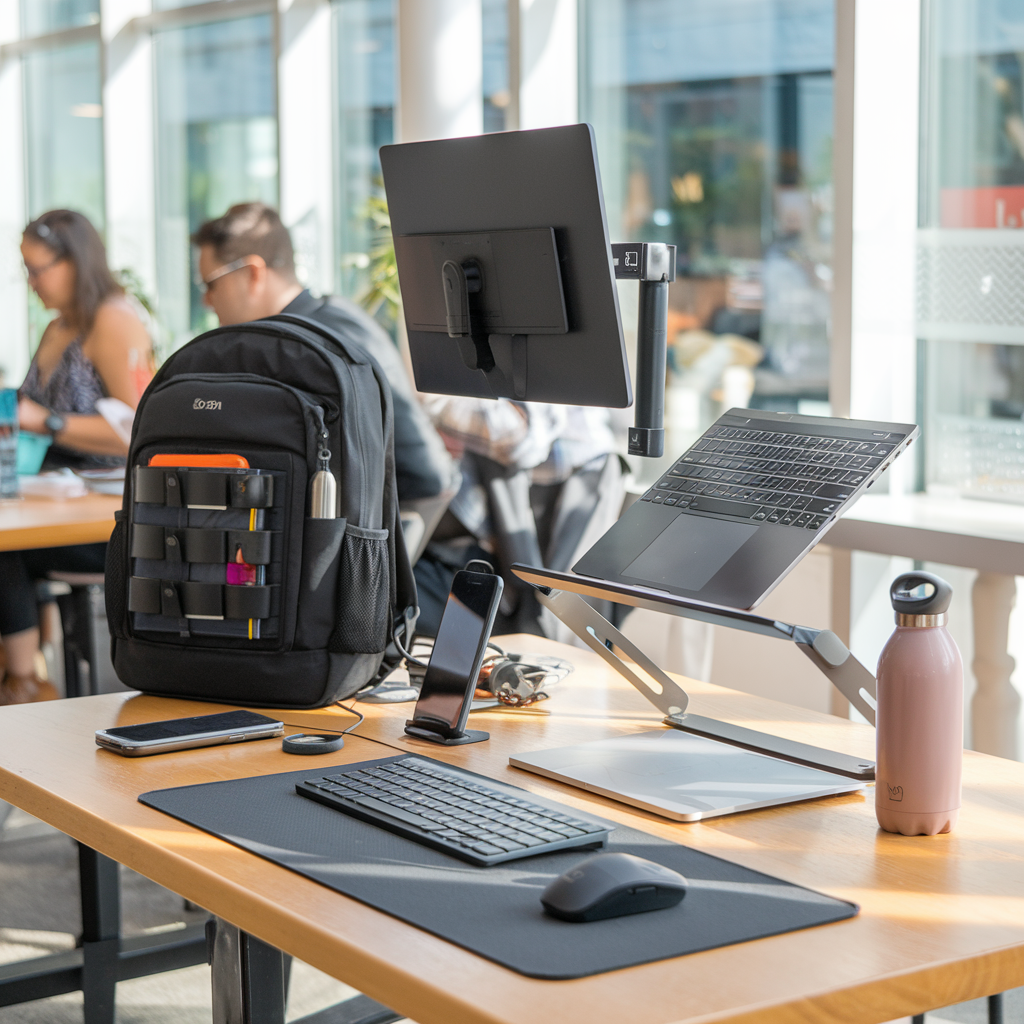
Your technology stack is the backbone of successful remote work travel. Here’s a comprehensive breakdown of everything you need to stay productive anywhere in the world.
Hardware Requirements
Laptop Specifications
The ideal travel work laptop should include:
-
Minimum 8-hour battery life
-
Lightweight (under 4 lbs/1.8 kg)
-
At least 16GB RAM for multitasking
-
SSD storage for faster performance
-
Latest generation processor (Intel i5/i7 or AMD equivalent)
-
Built-in webcam with HD quality
-
Recommended models: MacBook Air M2, Dell XPS 13, or Lenovo ThinkPad X1 Carbon
Mobile Devices
-
Smartphone with dual SIM capability
-
Tablet as backup work device (optional)
-
E-reader for reducing screen fatigue
-
Portable mouse and keyboard for ergonomics
Power Solutions and Adapters
-
Universal power adapter with surge protection
-
Portable power bank (20,000+ mAh)
-
USB-C hub with multiple ports
-
Backup charging cables
-
Voltage converter for high-powered devices
Software and Digital Tools
VPN Services
Essential for security and accessing home country services:
-
ExpressVPN or NordVPN for reliable global coverage
-
Split tunneling capability for bandwidth optimization
-
Kill switch feature for data protection
Cloud Storage Solutions
-
Google Drive (15GB free)
-
Dropbox (2TB plan recommended)
-
iCloud for Apple ecosystem
-
Regular backup automation
Project Management Tools
-
Asana or Trello for task management
-
Monday.com for team collaboration
-
ClickUp for comprehensive project oversight
-
Time Doctor for time tracking
Communication Platforms
Primary tools:
-
Slack for team chat
-
Zoom for video conferencing
-
Microsoft Teams for corporate environments
-
WhatsApp for international messaging
Backup communication:
-
Google Meet
-
Telegram
-
Signal for secure messaging
Pro Tip: Create a tech emergency kit with basic repair tools, spare cables, and a backup phone. Store critical work files offline on an encrypted external drive for peace of mind.
Maintaining Productivity While Traveling
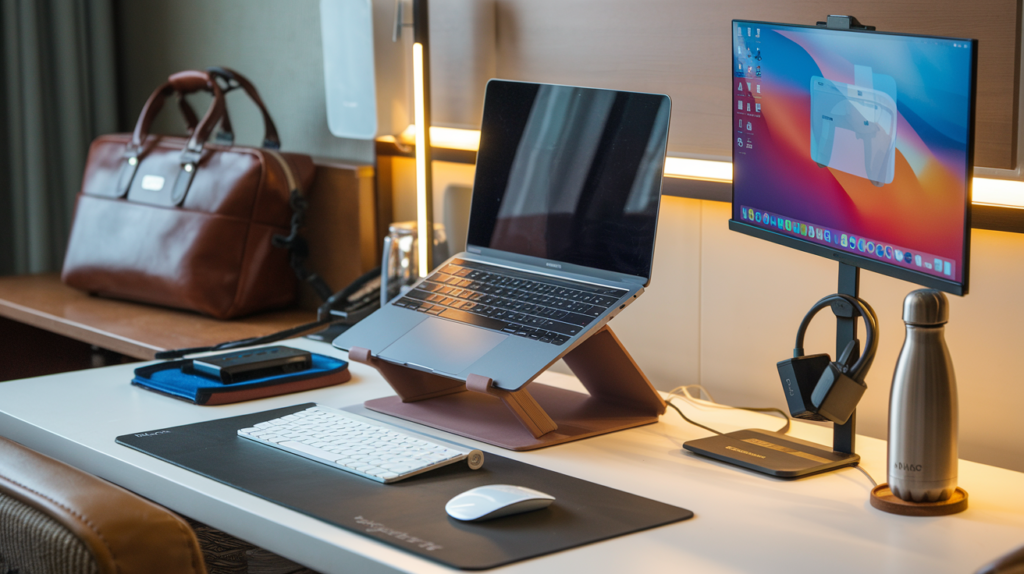
The key to successful remote work travel lies in creating systems that maintain your productivity regardless of location. Here’s how to optimize your work setup and time management for maximum efficiency.
Creating a Mobile Office Setup
Ergonomic Considerations
Your body is your most important asset. Prioritize these ergonomic elements:
-
Laptop stand to elevate screen to eye level
-
External keyboard and mouse for proper posture
-
Supportive cushion for various seating situations
-
Anti-glare screen protector for outdoor work
-
Noise-canceling headphones for focus
Essential Equipment
Pack these portable office essentials:
-
Collapsible laptop stand
-
Foldable bluetooth keyboard
-
Travel-sized wireless mouse
-
Mini LED desk lamp
-
Portable second screen
-
Cable organizers
-
Webcam light for professional video calls
Time Management Strategies
Work Scheduling Across Time Zones
Master the art of time zone management:
-
Use World Time Buddy for scheduling
-
Block your most productive hours for focused work
-
Schedule team meetings during overlap hours
-
Build buffer time between time zone transitions
-
Use asynchronous communication when possible
Managing Team Collaboration
Optimize remote team dynamics:
-
Set clear availability hours in team calendars
-
Use shared project management boards
-
Document everything for asynchronous handoffs
-
Schedule regular video check-ins
-
Utilize screen recording for detailed explanations
Setting Boundaries
Maintain work-life balance with these strategies:
-
Establish “deep work” periods
-
Create dedicated workspaces (avoid working from bed)
-
Use “Do Not Disturb” modes effectively
-
Set clear expectations with team members
-
Define start and end times for your workday
-
Use different devices/accounts for work and leisure
Pro Tip: Create a “productivity ritual” that you can replicate anywhere – whether you’re in a Bangkok café or a Barcelona coworking space. This consistent routine signals to your brain it’s time to focus, regardless of your exciting surroundings.
Staying Connected and Secure
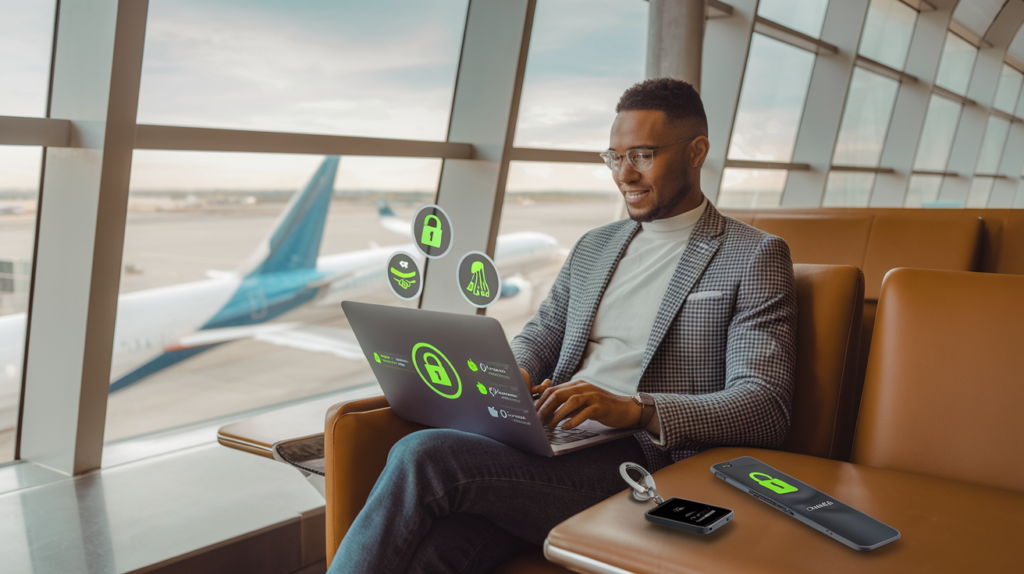
In the world of remote work travel, your internet connection and digital security are as crucial as your passport. Here’s how to stay connected and protected anywhere in the world.
Internet Connectivity Solutions
Local SIM Cards
-
Research local carriers before arrival
-
Purchase SIM cards at airports or official stores
-
Look for tourist-friendly data packages
-
Consider dual-SIM phones to maintain home number
-
Compare data allowances and coverage areas
Mobile Hotspots
-
Invest in a reliable global hotspot (Skyroam or GlocalMe)
-
Choose plans with unlimited data options
-
Consider device battery life
-
Check coverage maps for your destinations
-
Test speeds before relying on them for important calls
Backup Options
-
Map out local coworking spaces with reliable WiFi
-
Download offline work materials in advance
-
Keep a list of café chains known for good WiFi
-
Consider satellite internet for remote locations
-
Have an emergency fund for premium internet access
Digital Security Measures
Data Protection
-
Enable full-disk encryption on all devices
-
Use encrypted cloud storage services
-
Regular backup to external hard drives
-
Install reliable antivirus software
-
Enable remote device wiping capabilities
Secure Connections
-
Never use public WiFi without VPN protection
-
Enable two-factor authentication for all accounts
-
Use HTTPS everywhere browser extension
-
Avoid public computers for sensitive work
-
Monitor for unusual account activity
Password Management
-
Use a reputable password manager (LastPass, 1Password)
-
Generate unique passwords for each service
-
Regularly update security questions
-
Store backup codes in secure location
-
Implement biometric authentication when possible
Pro Tip: Create a “security checklist” to review weekly, ensuring all your protection measures are active and updated. Consider it your digital safety ritual, just as important as checking your physical passport.
Work-Life Integration on the Road

Mastering the balance between professional productivity and personal fulfillment is crucial for sustainable remote work travel. Here’s how to create harmony between your work and wanderlust.
Maintaining Work-Life Balance
Setting Routines
Create a flexible yet consistent daily structure:
-
Morning ritual (meditation, exercise, or journaling)
-
Dedicated work start and end times
-
Regular breaks for movement and exploration
-
Evening shutdown routine
-
Weekly planning sessions
Health and Wellness
Prioritize your physical and mental well-being:
-
Pack portable exercise equipment (resistance bands, yoga mat)
-
Use apps for workout routines (Nike Training Club, Down Dog)
-
Practice mindfulness or meditation
-
Maintain regular sleep schedule across time zones
-
Stay hydrated and maintain healthy eating habits
-
Schedule regular health check-ups in major cities
Social Connections
Combat isolation and build community:
-
Join digital nomad Facebook groups and forums
-
Attend local coworking events
-
Use Meetup.com for professional networking
-
Schedule regular video calls with family and friends
-
Participate in local community activities
Managing Remote Team Relationships
Communication Best Practices
Foster strong virtual connections:
-
Over-communicate rather than under-communicate
-
Use video calls for important discussions
-
Practice active listening and engagement
-
Share regular status updates
-
Be transparent about travel schedule and availability
-
Acknowledge cultural differences in communication styles
Virtual Collaboration
Maximize team effectiveness:
-
Create detailed documentation for all processes
-
Use visual collaboration tools (Miro, Figma)
-
Schedule regular virtual team building activities
-
Share travel experiences during team calls
-
Maintain a digital water cooler channel
-
Celebrate team wins and milestones virtually
Pro Tip: Create a “weekly check-in” template that covers both work progress and personal well-being. Share it with your team to maintain transparency while ensuring you’re taking care of yourself on the road.
Frequently Asked Questions About Remote Work Travel

How do I convince my employer to let me work remotely while traveling?
Present a detailed plan addressing time zone management, communication protocols, and productivity metrics. Highlight how remote work travel can benefit the company through increased productivity, cultural insights, and potential market expansion opportunities. Propose a trial period to demonstrate your ability to maintain or exceed current performance levels.
What’s the minimum internet speed needed for remote work?
For most remote work tasks, aim for at least 10 Mbps download and 1 Mbps upload speeds. However, for video calls and large file transfers, 20+ Mbps is recommended. Always test speeds before important meetings and have a backup connection ready.
How do I handle taxes as a digital nomad?
Consult with an international tax expert familiar with digital nomad arrangements. Many countries have specific requirements for remote workers, and you’ll need to understand both your home country’s obligations and those of your host countries.
What are the best destinations for remote work travel beginners?
Start with destinations that offer:
-
Reliable internet infrastructure
-
Established digital nomad communities
-
Similar time zones to your home base
-
Good healthcare systems
-
Safe environments Popular choices include Portugal, Croatia, Mexico, and Thailand.
How do I maintain work productivity while dealing with travel fatigue?
-
Implement a consistent morning routine
-
Stay in each location for at least 3-4 weeks
-
Schedule focused work during your peak energy hours
-
Take regular rest days between travels
-
Use time blocking to separate work and exploration
What essential insurance do I need for remote work travel?
-
International health insurance
-
Travel insurance with electronics coverage
-
Professional liability insurance
-
Income protection insurance
-
Emergency evacuation coverage
How can I build a professional network while traveling?
-
Join digital nomad communities on platforms like Nomad List
-
Attend local coworking space events
-
Use LinkedIn to connect with other traveling professionals
-
Participate in industry-specific meetups
-
Join virtual professional development groups
Remember: Successful remote work travel requires flexibility, planning, and a growth mindset. Start small, learn from each experience, and gradually optimize your setup as you go.
Embarking on Your Remote Work Travel Journey
The fusion of remote work and travel represents more than just a trending lifestyle – it’s a transformative way to experience the world while advancing your career. By following these remote work travel tips, you’re well-equipped to join the growing community of successful digital nomads.
Remember, the key to sustainable remote work travel lies in:
-
Thorough preparation and planning
-
Reliable tech setup and security measures
-
Consistent productivity habits
-
Strong work-life integration
-
Effective communication practices
Start small, perhaps with a two-week trial in a nearby city, and gradually expand your comfort zone. Join online digital nomad communities, connect with fellow remote workers, and never stop learning from those around you.
Ready to take the first step? Begin by creating your remote work travel checklist using the guidelines we’ve covered. Your adventure in location-independent work awaits – and the world is your office.
“The journey of a thousand miles begins with a single step” – and your first step towards remote work travel success starts now.
